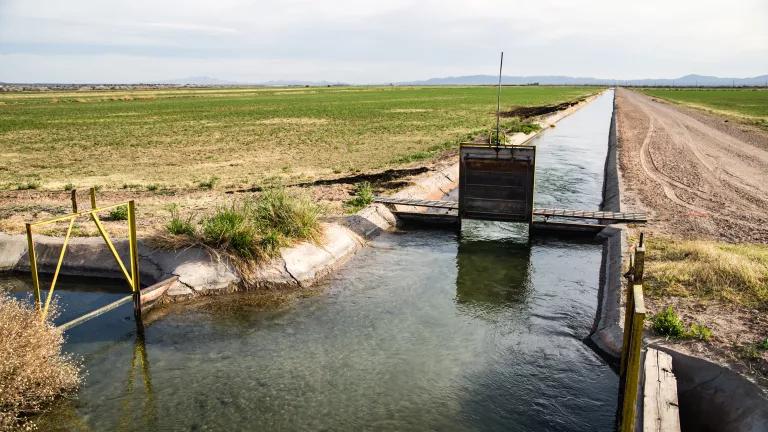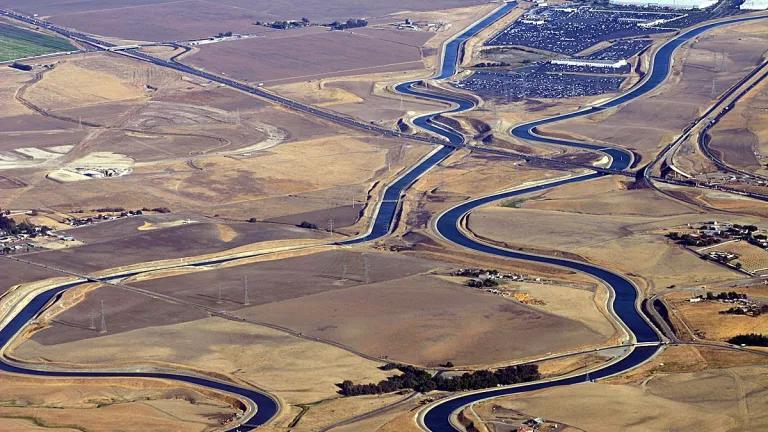Report: CA Ag Water Data Leaks through Mismanagement Cracks
California’s agricultural water suppliers—also called irrigation districts—are not complying with laws that require them to report on their water use. The lack of accurate water use data from our farms threatens the state’s ability to properly manage those water supplies.

Water control gate on California agricultural irrigation ditch
All of us in California have a role to play in reducing our water use, especially since our state is entering a new normal of longer, more frequent, and more extreme droughts. While our urban water users are improving water use efficiencies and integrating smarter management into their water planning, California’s agricultural water suppliers—also called irrigation districts—are not complying with laws that require them to report on their water use. In fact, a report published today by NRDC reveals that, from 2012-2016, only 12 percent of California’s large irrigation districts submitted all of their water delivery reports required under existing law. A shocking 28 percent of California’s large irrigation districts never submitted a farm-gate delivery report from 2012-2016, and 58 percent of farm-gate reports from those large irrigation districts were not submitted on time.
This is a problem because the lack of accurate water use data from our farms threatens the state’s ability to properly manage those water supplies. In 2016, Governor Brown signed an Executive Order that reinforced and strengthened the Department of Water Resources’ (DWR) mandate to collect water delivery data from irrigation districts in the form of an annual farm-gate delivery report—a requirement since 2012. NRDC submitted a request to DWR and collected farm-gate delivery reports from 2012-2015.
According to DWR, agency staff manually enter the data from farm-gate reports they receive via email and mail into its databases—a process that is prone to human error and not very helpful for meaningful data management. Additionally, DWR has two separate databases that contain different pieces of information, making management and data analysis even more cumbersome for the agency. Only in the last month has DWR beta-launched an online data portal for farm-gate delivery reports. While this beta-launch is a step in the right direction, the portal does not provide reports from 2012 and 2013 and it is still missing reports from 2014 through 2016. This disparate data availability does not make it easy for the public to know how much water is used by irrigation districts.
A majority of the state is still abnormally dry, affecting water availability for roughly 28 million Californians. Almost 14 percent of the state remains in severe or extreme drought conditions, and satellite data from the state’s sierra snowpack—a critical contributor to the state’s water supply—indicate that we are nowhere near normal levels of snowpack. One year after the drought emergency was lifted, cities are setting water conservation goals for the next decade. DWR and a majority of California’s irrigation districts, on the other hand, are failing to comply with existing state law.
DWR is responsible for managing and protecting California’s water resources. But California cannot manage what it does not measure, and DWR has to improve. While the launch of the online farm-gate portal is a step in the right direction, DWR staff still manually enter data from the farm-gate reports they receive into the portal. DWR should implement AB 1668 as quickly as possible, and move its filing and reporting into the 21st century by creating an electronic form that irrigation districts can use to submit reports online. This will help eliminate some of the filing and standardization errors, improve public access to data, and help DWR track which irrigation districts’ reports are missing. The agency should consolidate its databases to get a more accurate picture of the gaps in its current data, upload 2012 and 2013 data into the portal, and follow-up with irrigation districts on missing data. DWR should refer noncompliant irrigation districts to the State Water Resources Control Board for enforcement action, because irrigation districts should be penalized for repeatedly ignoring reporting requirements. Only then will the agency begin to fulfill its mission.
While many farms have improved water use efficiency over the past decade, there are still huge opportunities to make further improvements that can save water and money. Accurate measurement of farm water use will lead to more effective management of farm water use. The rest of the State is counting on it.




